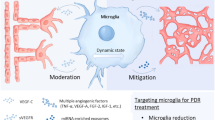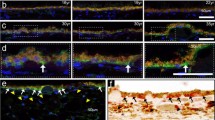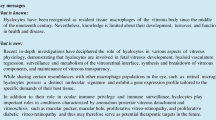Abstract
Purpose
To analyze the influence of oxidative stress on retinal ganglion cells (RGCs) by using a selective culture system of rat RGCs.
Methods
Rat RGCs were purified by a two-step immunopanning procedure and cultured either with or without antioxidant (AO) compounds. Reactive oxygen species (ROS) in RGCs were analyzed using dihydroethidium. Expression of angiotensin II, cleaved caspase 3, and netrin-1 was analyzed by immunocytochemistry. Live RGCs were detected by use of calcein-acetoxymethyl ester. The roles of angiotensin II type 1 receptor (AT1R) signaling and netrin-1 were analyzed by use of an AT1R blocker (telmisartan) and an anti-netrin-1 neutralizing antibody, respectively.
Results
ROS and angiotensin II were induced in RGCs cultured without AO compounds (AO−). In these cultures, the number of live RGCs decreased and expression of cleaved and activated caspase 3 increased, but these changes were attenuated by addition of the AT1R blocker. Reduction in netrin-1 expression under the AO− condition was also prevented by the AT1R blocker. The AT1R blocker’s effects on RGC survival and reduction in cleaved caspase 3-positive cells were cancelled by the anti-netrin-1 neutralizing antibody.
Conclusions
Oxidative stress induced cell death through AT1R signaling and netrin-1 reduction in cultured RGCs.





Similar content being viewed by others
References
Ozawa Y, Sasaki M, Takahashi N, Kamoshita M, Miyake S, Tsubota K. Neuroprotective effects of lutein in the retina. Curr Pharm Des. 2012;18:51–6.
Yuki K, Ozawa Y, Yoshida T, Kurihara T, Hirasawa M, Ozeki N, et al. Retinal ganglion cell loss in superoxide dismutase 1 deficiency. Invest Ophthalmol Vis Sci. 2011;52:4143–50.
Yuki K, Murat D, Kimura I, Ohtake Y, Tsubota K. Reduced-serum vitamin C and increased uric acid levels in normal-tension glaucoma. Graefes Arch Clin Exp Ophthalmol. 2010;248:243–8.
Yang H, Hirooka K, Fukuda K, Shiraga F. Neuroprotective effects of angiotensin II type 1 receptor blocker in a rat model of chronic glaucoma. Invest Ophthalmol Vis Sci. 2009;50:5800–4.
Hirooka K, Baba T, Fujimura T, Shiraga F. Prevention of visual field defect progression with angiotensin-converting enzyme inhibitor in eyes with normal-tension glaucoma. Am J Ophthalmol. 2006;142:523–5.
Hashizume K, Mashima Y, Fumayama T, Ohtake Y, Kimura I, Yoshida K, et al. Genetic polymorphisms in the angiotensin II receptor gene and their association with open-angle glaucoma in a Japanese population. Invest Ophthalmol Vis Sci. 2005;46:1993–2001.
Ozkur M, Erbagci I, Gungor K, Nacak M, Aynacioglu S, Bekir NA. Angiotensin-converting enzyme insertion–deletion polymorphism in primary open-angle glaucoma. Ophthalmologica. 2004;218:415–8.
Chen P, Guo AM, Edwards PA, Trick G, Scicli AG. Role of NADPH oxidase and ANG II in diabetes-induced retinal leukostasis. Am J Physiol Regul Integr Comp Physiol. 2007;293:R1619–29.
Ozawa Y, Kurihara T, Sasaki M, Ban N, Yuki K, Kubota S, et al. Neural degeneration in the retina of the streptozotocin-induced type 1 diabetes model. Exp Diabetes Res. 2011;108328.
Inatani M. Molecular mechanisms of optic axon guidance. Naturwissenschaften. 2005;92:549–61.
Chan SS, Zheng H, Su MW, Wilk R, Killeen MT, Hedgecock EM, et al. UNC-40, a C. elegans homolog of DCC (deleted in colorectal cancer), is required in motile cells responding to UNC-6 netrin cues. Cell. 1996;87:187–95.
Deiner MS, Kennedy TE, Fazeli A, Serafini T, Tessier-Lavigne M, Sretavan DW. Netrin-1 and DCC mediate axon guidance locally at the optic disc: loss of function leads to optic nerve hypoplasia. Neuron. 1997;19:575–89.
Park KW, Crouse D, Lee M, Karnik SK, Sorensen LK, Murphy KJ, et al. The axonal attractant netrin-1 is an angiogenic factor. Proc Natl Acad Sci. 2004;101:16210–5.
Wilson BD, Ii M, Park KW, Suli A, Sorensen LK, Larrieu-Lahargue F, et al. Netrins promote developmental and therapeutic angiogenesis. Science. 2006;313:640–4.
Xu H, Liu J, Xiong S, Le YZ, Xia X. Suppression of retinal neovascularization by lentivirus-mediated netrin-1 small hairpin RNA. Ophthalmic Res. 2011;47:163–9.
Arakawa H. Netrin-1 and its receptors in tumorigenesis. Nat Rev Cancer. 2004;4:978–87.
Furne C, Rama N, Corset V, Chedotal A, Mehlen P. Netrin-1 is a survival factor during commissural neuron navigation. Proc Natl Acad Sci. 2008;105:14465–70.
Tang X, Jang SW, Okada M, Chan CB, Feng Y, Liu Y, et al. Netrin-1 mediates neuronal survival through PIKE-L interaction with the dependence receptor UNC5B. Nat Cell Biol. 2008;10:698–706.
Wu TW, Li WW, Li H. Netrin-1 attenuates ischemic stroke-induced apoptosis. Neuroscience. 2008;156:475–82.
Nakayama M, Aihara M, Chen YN, Araie M, Tomita-Yokotani K, Iwashina T. Neuroprotective effects of flavonoids on hypoxia-, glutamate-, and oxidative stress-induced retinal ganglion cell death. Mol Vis. 2011;17:1784–93.
Uchida S, Suzuki Y, Araie M, Kashiwagi K, Otori Y, Sakuragawa N. Factors secreted by human amniotic epithelial cells promote the survival of rat retinal ganglion cells. Neurosci Lett. 2003;341:1–4.
Kurihara T, Ozawa Y, Nagai N, Shinoda K, Noda K, Imamura Y, et al. Angiotensin II type 1 receptor signaling contributes to synaptophysin degradation and neuronal dysfunction in the diabetic retina. Diabetes. 2008;57:2191–8.
Sasaki M, Ozawa Y, Kurihara T, Kubota S, Yuki K, Noda K, et al. Neurodegenerative influence of oxidative stress in the retina of a murine model of diabetes. Diabetologia. 2010;53:971–9.
Wilkinson-Berka JL. Angiotensin and diabetic retinopathy. Int J Biochem Cell Biol. 2006;38:752–65.
Kurihara T, Ozawa Y, Shinoda K, Nagai N, Inoue M, Oike Y, et al. Neuroprotective effects of angiotensin II type 1 receptor (AT1R) blocker, telmisartan, via modulating AT1R and AT2R signaling in retinal inflammation. Invest Ophthalmol Vis Sci. 2006;47:5545–52.
Chao MV. Dependence receptors: what is the mechanism? Sci STKE. 2003. doi:10.1126/stke.2003.200.pe38.
Mehlen P, Thibert C. Dependence receptors: between life and death. Cell Mol Life Sci. 2004;61:1854–66.
Mehlen P, Rabizadeh S, Snipas SJ, Assa-Munt N, Salvesen GS, Bredesen DE. The DCC gene product induces apoptosis by a mechanism requiring receptor proteolysis. Nature. 1998;395:801–4.
Shi M, Zheng MH, Liu ZR, Hu ZL, Huang Y, Chen JY, et al. DCC is specifically required for the survival of retinal ganglion and displaced amacrine cells in the developing mouse retina. Dev Biol. 2010;348:87–96.
Grenz A, Dalton JH, Bauerle JD, Badulak A, Ridyard D, Gandjeva A, et al. Partial netrin-1 deficiency aggravates acute kidney injury. PLoS One. 2011;6:e14812.
Acknowledgments
We thank Dr Mao Nakayama, Dr Nyu Rong, and Ms Haruna Koizumi-Mabuchi for technical assistance. The telmisartan was kindly provided by Boehringer Ingelheim, Germany. This study was supported, in part, by a Keio University Gakujishinkoushikin grant to Y.O. The angiotensin II type 1 receptor blocker was a gift from Boehringer Ingelheim, Germany.
Author information
Authors and Affiliations
Corresponding author
About this article
Cite this article
Ozawa, Y., Yuki, K., Yamagishi, R. et al. Renin–angiotensin system involvement in the oxidative stress-induced neurodegeneration of cultured retinal ganglion cells. Jpn J Ophthalmol 57, 126–132 (2013). https://doi.org/10.1007/s10384-012-0204-x
Received:
Accepted:
Published:
Issue Date:
DOI: https://doi.org/10.1007/s10384-012-0204-x




